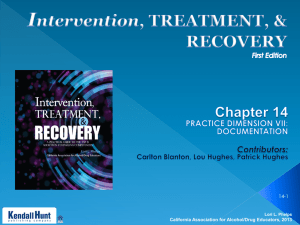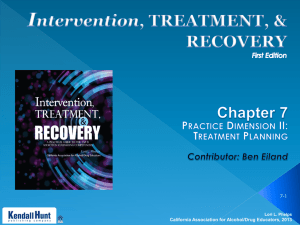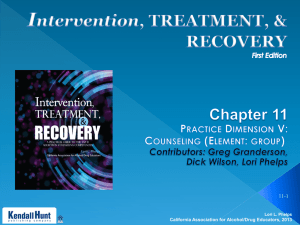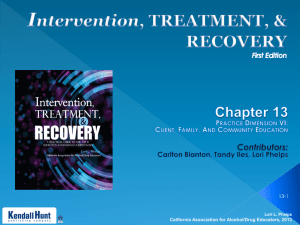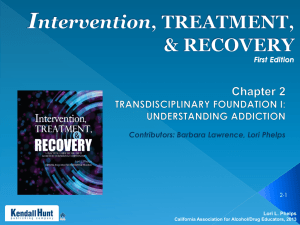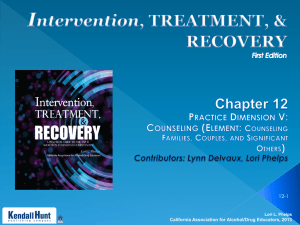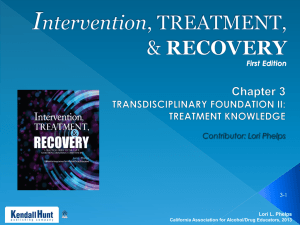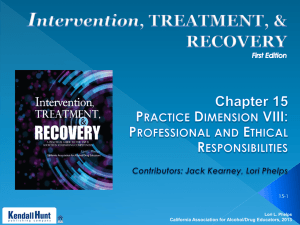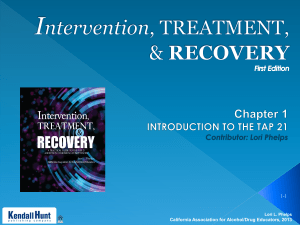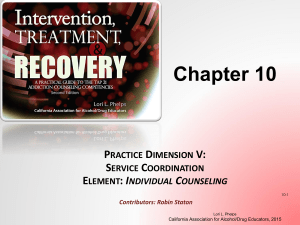Chapter 14 ppt - California Association for Alcohol/Drug Educators
advertisement
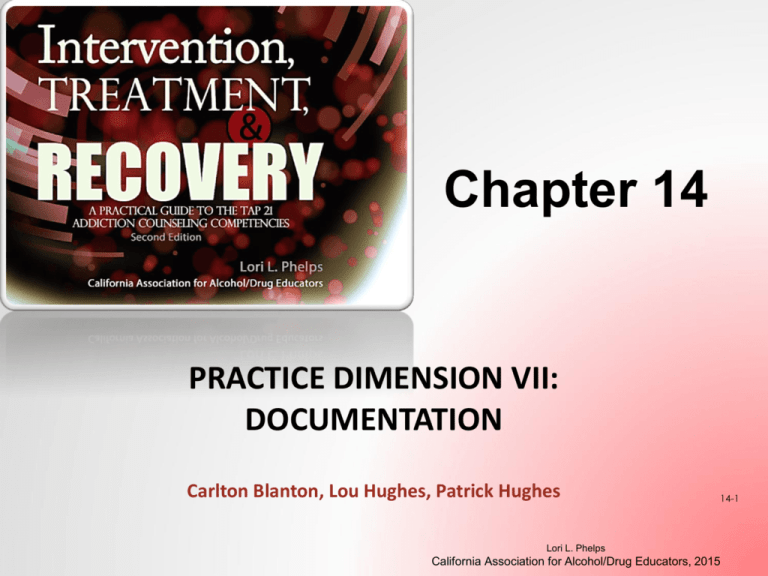
Chapter 14 PRACTICE DIMENSION VII: DOCUMENTATION Carlton Blanton, Lou Hughes, Patrick Hughes 14-1 Lori L. Phelps California Association for Alcohol/Drug Educators, 2015 Competencies 108-114 Competency 108: Demonstrate knowledge of accepted principles of client record management. Competency 109: Protect client rights to privacy and confidentiality in the preparation and handling of records, especially in relation to the communication of client information with third parties. Competency 110: Prepare accurate and concise screening, intake, and assessment reports. Lori L. Phelps California Association for Alcohol/Drug Educators, 2015 14-2 Competencies 108-114 Competency 111: Record treatment and continuing care plans that are consistent with agency standards and comply with applicable administrative rules. Competency 112: Record progress of client in relation to treatment goals and objectives. Competency 113: Prepare accurate and concise discharge summaries. Competency 114: Document treatment outcome, using accepted methods and instruments. Lori L. Phelps California Association for Alcohol/Drug Educators, 2015 14-3 Client Record Management • Selecting and recording the appropriate treatment/recovery options for clients • Assuring your agency remains in fiscal compliance with its funding agencies. • Important Forms: • • • • • Release of information Assessments Treatment/recovery plans Progress notes Discharge summaries/continuing care plans. Lori L. Phelps California Association for Alcohol/Drug Educators, 2015 14-4 Essential Counselor Skills • Writing legibly, clearly, concisely • Understanding state and county standards, policies, and procedures • Proper recording of treatment/recovery plan information is critical • Key Elements include: • listing AOD-related problems including medical, family, vocational, and social issues • developing short-term and long-term objectives • preparing a plan of action to meet objectives • tracking client progress toward meeting objectives • writing a discharge summary/continuing care plan Lori L. Phelps California Association for Alcohol/Drug Educators, 2015 14-5 Progress Notes • The Treatment plan is the blueprint for recovery (the big picture) • Progress notes record the details of what does or does not happen during actual treatment • any treatment/recovery plan changes • changes in client’s status, behavior, and functioning levels. • Counselors must know clinical terminology • Counseling sessions must be documented within 14 days. Lori L. Phelps California Association for Alcohol/Drug Educators, 2015 14-6 Discharge Summary & Continuing Care Plan Discharge Summary Continuing Care Plan Client’s profile and Aftercare options based on demographics client’s success in treatment Client’s presenting symptoms program Selected interventions Contacting appropriate and Critical incidents needed resources to determine Progress toward meeting availability (e.g., further treatment goals treatment, options for housing, Discharge recommendations education, training, family, legal) (e.g., further treatment, options Scheduling AA meetings, for housing, education, training, meeting legal obligations, and family, legal) attending alumni meetings 14-7 Documenting Treatment Outcome • TWO KEY EVALUATION TERMS • Process • includes recording individual and group sessions attended, session topics, number and results of urinalysis testing, and treatment plans prepared and modified • Outcome • documents for individual clients if primary program goals were achieved (did recovery happen? was sobriety maintained? were educational, vocational, behavioral, social, and family goals achieved?) Lori L. Phelps California Association for Alcohol/Drug Educators, 2015 14-8 Charting and Documentation • Charting • reflects what actually happened; e.g., completion of program, dirty drug test, client left against staff advice • a legal/ethical responsibility • Counselors must document before leaving their shifts • Under current law, HIV status may not be listed on a regular chart (such info is stored separately in a secure chart). • Use phrases such as “special medical needs” for regular chart Lori L. Phelps California Association for Alcohol/Drug Educators, 2015 14-9 Protect Your Client • The criminal justice system sometimes finds ways to get charts and use the information to penalize or prosecute patients. • Do not record information that could come back to harm your client; • use language that would identify the issue for staff but is vague enough that non-staff could not use it against the client. Lori L. Phelps California Association for Alcohol/Drug Educators, 2015 14-10 Areas Requiring Documentation • • • • • • • Medical Employment Alcohol/Drug Legal Family Social Psychiatric ©Modella/Shutterstock.com Lori L. Phelps California Association for Alcohol/Drug Educators, 2015 14-11 Treatment Plan Documentation Notes • The client and the counselor prepare the treatment plan together. • Client agrees to outline a recovery plan of action for the next 89 days (treatment plan must be updated within 90 days). • Client and counselor sign and date treatment plan. • Supervisor and medical director sign and date treatment plan. • Treatment plans must be updated if major treatment changes occur (e.g., failed UA tests, not attending AA meetings, missing group sessions). Lori L. Phelps California Association for Alcohol/Drug Educators, 2015 14-12 Treatment Plan Terms • Modality: Type of service programs • • • • • Residential Outpatient Day care Narcotic treatment Perinatal • DSM • Diagnostic and Statistical Manual of Mental Disorders • ST/LT: Short term/Long term goals • TX: Treatment Lori L. Phelps California Association for Alcohol/Drug Educators, 2015 14-13 Progress Notes • Objective reporting of client’s attitudes, behavior, and progress (or lack of progress) toward meeting shortand long-term objectives • Good example: • Client decided to leave program against staff advice. He was given referrals to other programs as well as program referral list. He left with his wife at 5:20 pm. He took all his belongings including his prescribed medications. • Poor examples: • Client used so we kicked him out last week. • OR • Client left program because we were going to kick him out anyway. 14-14 Progress Notes Points to Remember • The chart is a legal document and counselors are accountable for everything in it. • Always sign your name, highest academic degree if applicable, license certification and your job title (service coordinator, counselor, intern, LCSW, MFT, MD). • Every page in the chart must have the participant’s name • All notes should be written in black ink. • Participants should not sign a blank Release of Information form. • Do not speak to anyone regarding a participant without a signed Release of Information form. • Mistakes: Cross out with one line and write the word Error, date, and initial above it. Do not erase or use white-out! Lori L. Phelps California Association for Alcohol/Drug Educators, 2015 14-15 More Points to Remember • Identify only the participant in the document. Use mother, father, friend, etc., to name others. Do not use a specific name. In a group, write group participant by first name or initials. Do not use full name of any participant in another participant’s chart. • All notes, including telephone calls, must reflect interventions and participant response to intervention. • Progress notes must reflect either the plan goal or the stated goal for the session. • Charts are never to leave the facility except for audit purposes. • There should be no blank space/pages in the chart. • Draw a diagonal line through unused space. • Transportation is not a billable service. Accompanying a participant to an appointment and providing intervention while in transit and at the appointment are billable. 14-16 Useful Words/Phrases for Charting Staff Interventions Acknowledged Clarified Demonstrated Directed Educated Encouraged Engaged Established Facilitated Helped improve Implemented Impressed Informed Initiated Inquired Intervened Introduced Modeled Prompted Recommended Redefined Redirected Referred Reflected Lori L. Phelps California Association for Alcohol/Drug Educators, 2015 Reframed Reinforced Role-modeled Suggested Supported Urged Validated 14-17 Discharge/Summary Statement • Vital • Correct Documentation • Participant continues to experience difficulty in [XXX identify goal] due to lack of [XXX be specific and give behavioral examples, e.g., skills development, low self-esteem, lack of motivation, hearing voices, poor skills in [XXX], ongoing depression, etc.]. • Participant has shown growth in the area(s) of [XXX] and has been given praise and recognition. • Incorrect Documentation • Participant has improved. Participant no longer has [XXX]. Participant has no need for further [XXX ]. 14-18 Internet Resources The Clinician’s Guide to Writing Treatment Plans and Progress Notes https://www.sccgov.org/sites/dads/Adult%20System%20of%20Care%20Po licy%20-%20Procedure/Documents/Clinician_Gde_toolkit.pdf Sample Substance Use Disorder Program Discharge Summary http://www.ncbi.nlm.nih.gov/books/NBK64383/#A54389 Lori L. Phelps California Association for Alcohol/Drug Educators, 2015 14-19 Videos/Webcasts • Medication Treatment, Evaluation, and Management (MedTEAM) https://www.youtube.com/watch?v=S5UCp9HHgl E • See MedTEAM Kit at: http://store.samhsa.gov/product/MedTEAM-MedicationTreatment-Evaluation-and-Management-Evidence-BasedPractices-EBP-KIT/SMA10-4549 14-20 Exercises/Activities • Illness management and recovery: Practitioner guides and handouts http://store.samhsa.gov/shin/content//SMA094463/PractitionerGuidesandHandouts.pdf 14-21 Lori L. Phelps California Association for Alcohol/Drug Educators, 2015

